GASTRONOMY OF BAJA CALIFORNIA SUR
Mexico » States » Baja California Sur » Gastronomy
Cover photo by tipsparatuviaje.com
Typical Food of BAJA CALIFORNIA SUR
The food culture in Baja California Sur is fascinating, and it allows visitors to appreciate the fantastic local products, which are integral to the regional cuisine. Baja California Sur has a lot to offer, with a rich regional cuisine and a wide range of restaurants that serve dishes of international cuisine. The gastronomy of Baja California Sur is mainly focused on seafood that comes from the Sea of Cortez and the Pacific Ocean, which surround the region.
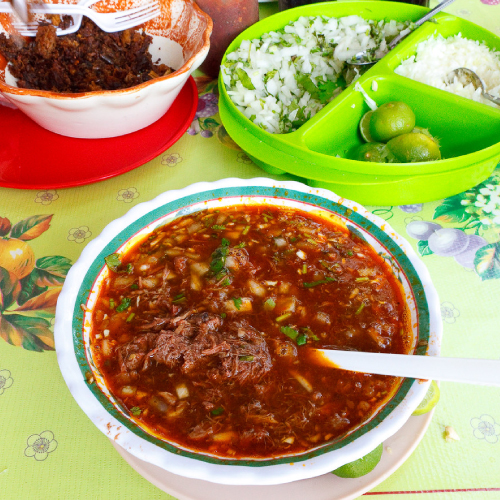
The culinary traditions in this state date back thousands of years when the first settlers practiced hunting, fishing, and gathering fruits as a means of subsistence. Later, when the Jesuits arrived, they introduced new crops like vine, olive trees, wheat, and corn, as well as the breeding of pigs, cattle, and goats, which opened up new opportunities for culinary exploration in the region. The new crops and livestock led to the development of new dishes, resulting from the fusion of Jesuit and native cultures.
The region’s gastronomic culture evolved with time, creating an extensive menu that takes advantage of the natural wealth of products found on land, but mainly consists of the abundance that comes from the sea. The visitor can enjoy the exotic and delicious fish and shellfish dishes that are integral to the typical cuisine of Baja California Sur, such as lobster, sole, tripe, grilled clams, chili stuffed with fish, abalone fillets, breaded with garlic sauce or in a cocktail, the imperial shrimp fillet, and seafood tacos, among others.
Baja California Sur has a fascinating history that influences its cuisine. The arrival of the Jesuits in the region brought a significant change in the culinary culture, which was later modified when they were expelled from the peninsula, halting the creation of new dishes that were a fusion of Jesuit and native cultures. However, the region’s gastronomic culture has continued to evolve, with the most demanding visitors surprised by the dishes that include clams, snails, marlin, tuna, among others.
The hospitality that distinguishes the inhabitants of Baja California Sur is evident in the cities and towns, where visitors will find everything they need for a good meal. The visitor can indulge in the typical cuisine of the region or explore international cuisine, which is also prevalent in the region, especially in Los Cabos. The international cuisine is favored by marine products and is created by prestigious Mexican and foreign chefs who come from all over the world.
Typical Dishes of BAJA CALIFORNIA SUR
Lobster in Butter
Lobster in butter is considered one of the stars of Baja California Sur’s gastronomy, and for good reason. This exclusive dish is prepared using the delicate meat of the crustacean and is a gourmet delight. Lobster is present practically throughout the length and breadth of the Baja California peninsula, but in its southern end, this delicacy is a must-have in its gastronomy.
The South Californian lobster is caught by hand using traps, ensuring that it suffers almost no damage. This method of capture guarantees that the lobster is fresh and of the highest quality. Once caught, the lobster is cooked in butter, which gives it a creamy and rich flavor. It is usually accompanied by rice, beans, coleslaw, and sauces, making it a complete and satisfying meal.
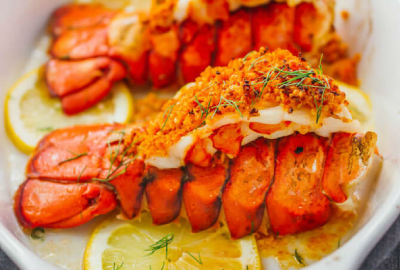
Although lobster in butter was once found more frequently in expensive restaurants, nowadays, it is more common to find it in various places in Baja California Sur. This dish has become popular among locals and tourists alike, and it is not uncommon to see it on the menu of many seafood restaurants in the region.
Apart from lobster in butter, there are other ways to enjoy lobster in Baja California Sur. For example, you can try it grilled, baked, or in a soup. Each method of preparation brings out different flavors and textures in the meat, making it a versatile ingredient in the local cuisine.
Grilled Fish
Grilled fish is one of the main dishes in Baja California Sur that you can enjoy during a barbecue with family and friends, as well as on a weekend at home or on the beach. It is a simple yet delicious dish that is ideal for those who love seafood and enjoy cooking outdoors. The dish requires a barbecue or grill, and the ingredients you need are fish, onion, tomatoes, orange juice, huichol sauce, and mustard.
There are various types of fish that you can use for this dish, such as goldfish, swordfish, roosterfish, marlin, and horse mackerel. Each type of fish has its own unique flavor and texture, and the choice of fish can significantly affect the overall taste of the dish.
To prepare grilled fish, the fish is first cleaned and then coated evenly with sauces and juices. The marinade adds depth and complexity to the flavor of the fish, making it more savory and flavorful. The fish is then grilled, constantly turning it over for 25 minutes, until it is cooked to perfection. Once done, it is covered with fried vegetables, adding an extra layer of flavor and texture.
Apart from being delicious, grilled fish is also a healthy option for those who are health-conscious. Fish is a good source of protein and omega-3 fatty acids, which are essential for maintaining a healthy diet.
Ceviche
Ceviche is another beloved dish of Baja California Sur that has its roots in the coastal cuisine of Latin America. The dish is typically made with raw fish that is marinated in citrus juices, such as lime or lemon, and mixed with onions, tomatoes, and chiles. The acidity of the citrus juices “cooks” the fish, giving it a firm texture and a bright, fresh flavor.
In Baja California Sur, ceviche is a popular dish that showcases the region’s abundant seafood. Local chefs use a variety of white fish, such as corvina or snapper, to create unique variations of the dish. One popular local ingredient is the cochito fish, which is a type of grouper that is prized for its firm, flavorful meat. Some chefs also add other seafood, such as shrimp or octopus, to the ceviche for a more complex flavor profile.
Ceviche is a versatile dish that can be served as an appetizer or a main course. It is typically accompanied by tortilla chips or tostadas, which are crispy fried tortillas. The dish is also commonly garnished with avocado, cilantro, and lime wedges for added freshness and flavor.
Stingray Machaca
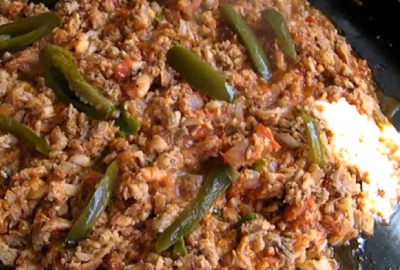
Stingray machaca is a staple dish of Baja California Sur that reflects the ingenuity and resourcefulness of the region’s people. In times of drought and scarcity, when beef became too expensive, the locals turned to the manta ray as a substitute for meat. The dish originated as a variation of the traditional beef machaca, where the meat is shredded with the hands instead of crushed with a stone or other blunt object.
Today, stingray machaca has become a beloved dish that showcases the unique flavors and ingredients of the region’s cuisine. To prepare stingray machaca, the meat is cooked in seasoned water with onion, bay leaf, and salt, and then shredded with the fingers. The meat is then fried along with onions and serrano chiles in strips.
The finished dish is typically served with flour or corn tortillas, refried beans, and rice. One of the distinctive features of stingray machaca is its texture, which is chewy and slightly fibrous. The dish has a mild, delicate flavor that is complemented by the tangy and spicy notes of the onions and chiles.
Pescado empapelado (Fish Wrapped in Aluminum Foil)
Fish wrapped in aluminum foil, or “pescado empapelado” in Spanish, is a typical dish of Baja California Sur that offers a unique combination of flavors and textures. This dish is made by stuffing a cleaned fish weighing at least 1.5 kilos with strips of tomatoes, jalapeño and poblano peppers, and onion. The fish is then wrapped in aluminum foil and roasted until cooked. The result is a delicious and flavorful fish that is perfect for sharing.
To accompany the fish, you can make a molcajete sauce by boiling tomatoes and serrano chili, then grinding and seasoning with garlic powder and salt. Another version of this dish is to roast the fish with cuts of vegetables like potatoes, carrots, and zucchini, for a healthy and balanced meal.
Beef machaca
It is a dish made from dried beef that has been totally dehydrated, using an ancestral preservation technique that involves hanging it out in the sun and wind. The technique gives the meat a peculiar texture and flavor, which helps keep it in good condition for a long time. This dish has its roots in the indigenous culture of the northern zone of Mexico, where native settlers used to carry rolls of dried meat as a provision in their daily life and on their trips. They ate it as is without any seasoning, but eventually, they started adding quail eggs to the meat, which they crushed and shredded with stones.
The dish evolved over time, and after the Spanish conquest, salty beef of Spanish origin and other elements of flavor were incorporated into the meat to create the current machaca. The machaca was born in the state of Nuevo León and has become an exquisite dish, not only in the northern side of Mexico but throughout the country.
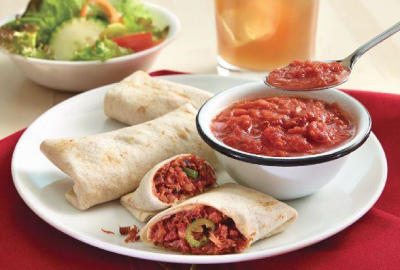
The preparation process is practically the same everywhere, with the first step being to cut and salt the meat. Then, the protein is left in the sun to dry and get a light brown color on both sides. The meat is then browned on the grill, rehydrated to remove the extra salt, and softened. In Baja California Sur, the dish is often served with onion and poblano pepper chopped into long, thin strips, and it is a popular filling for corn tortillas and empanadas.
In Baja California Sur, you can select between beef or fish for the machaca, which is its main ingredient after tortillas. If you prefer to make the machaca with beef, you can find the dehydration steps in the previous dish. However, the other ingredients that you need to continue are garlic, onion, guajillo peppers, tomatoes, wheat flour, and vinegar. After frying the dried meat with the rest of the ingredients, you can fill the tortillas.
Beef Machaca Burritos
If you add the word “burrito” to beef machaca, you get another typical dish from the northern region of Mexico. The beef machaca burrito is a delight that has become part of the culture and gastronomy of Baja California Sur. The meat is tanned with salt and dried in the sun, just like in the previous dish, and then crushed or “machaca” with a stone. The most typical way to prepare the machaca is stewed or scrambled with egg, prepared with chili, onion, and tomato. To make the burrito, you just have to fold the flour tortilla at the top and bottom ends and roll it up like a taco.
Beef machaca is a dish that represents the cultural and culinary heritage of Baja California Sur. Its unique taste and texture make it a favorite of locals and visitors alike. Whether you prefer it as a stew, scrambled with eggs, or as a filling for burritos, beef machaca is a must-try when visiting this beautiful state.
Stuffed Shrimp
The stuffed shrimp is another popular dish in Baja California Sur that will leave you craving for more. The dish is typically prepared by stuffing giant shrimp with cheese and wrapping them in bacon before frying them in hot oil. The result is a mouthwatering combination of flavors and textures that will leave you wanting more.
In Baja California Sur, the cheese-stuffed shrimp is usually served with a side of rice, salad, or a delicious sauce that complements the dish perfectly. Whether you are attending a family celebration or dining out at a local restaurant, you are bound to come across this delicious delicacy.
One of the best places to try the cheese-stuffed shrimp in Baja California Sur is Mariscos Los Laureles, a popular restaurant that is renowned for its fresh seafood and traditional Mexican dishes. The restaurant serves the shrimp alone or in the Sinaloan style, which is accompanied by a lettuce, tomato, cucumber, and radish salad.
La Paz Style Fish Tacos
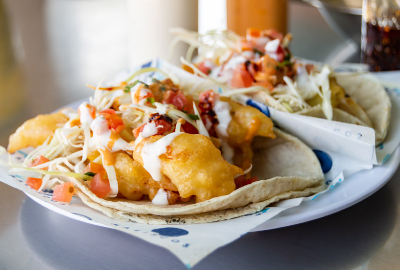
La Paz style fish tacos are another must-try dish when visiting Baja California Sur. This dish is made by battering fish with a mixture of flour and frying it until golden and crispy. The fish is then served in tacos with flour tortillas and garnishes like jalapeño peppers.
Fish is a common ingredient in Baja California Sur’s cuisine due to its proximity to the sea. Other popular fish dishes in the region include ceviche, grilled fish, zarandeado, and tatemado. Fish tacos are one of the most famous dishes in Mexican cuisine, and the La Paz style adds a unique twist to this beloved dish.
The recipe for La Paz style fish tacos is quick and easy to follow, and the fish does not require marinating the day before. The fish is prepared in tempura, which is a nod to the cultural and gastronomic influence of Asians in Baja California Sur.
In addition to La Paz style fish tacos, there are also fish tacos in the “ensenada” style, originating from the port city of Ensenada. This dish is typically served for breakfast or informal occasions all year round and is made with corn or flour tortillas, fish, light beer, and jalapeño pepper.
Tamales from Baja California Sur
One of the most popular dishes in Baja California Sur is the tamale. Tamales are a traditional Mexican dish made from masa (a dough made from corn) that is usually filled with meat, vegetables, or chilies, and then wrapped in a corn husk and steamed. The tamale is part of the culinary art of Baja California Sur with the same intensity as in all of Mexico, with the distinctive touches that the regions give to this national dish.
In December, the festival “El tamale le dijo a la olla” is celebrated in Cabo San Lucas. This event is organized to rescue and promote the most authentic way of eating South Californian tamales. The festival offers visitors the opportunity to taste a variety of tamales made from different regions of Baja California Sur. The tamales are typically served with salsa, guacamole, and other traditional Mexican sides.
Fish meatballs
This dish is quick and easy to prepare, making it ideal for a family lunch or dinner, at any time of the year. Fish meatballs are made of small spheres of ground fish in a stew of garlic, onion, poblano peppers, and tomatoes. The dish can be prepared using sea bass, marlin, or horse mackerel fillets. If the fillets are not pre-filleted, one must remove the heads, scales, and spines before grinding and seasoning with salt and pepper.
To prepare fish meatballs, first grind the fillets and season with salt and pepper. Then, proceed to simmer the tomato broth with the meatballs. Shrimp can also be added to the dish to add more flavor and texture. The resulting dish is a delicious and healthy meal that can be served with rice or tortillas.
Imperial shrimp fillet
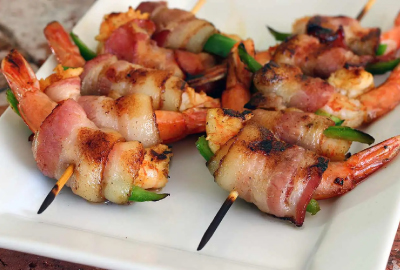
Another dish that is highly sought-after in Baja California Sur is imperial shrimp fillet. This delicacy consists of pre-cooked shrimp that are wrapped in bacon and then grilled to perfection. The dish is finished with a coriander-based dressing that adds a burst of flavor to the already delicious combination of shrimp and bacon.
To prepare imperial shrimp fillet, the shrimp are first cleaned and pre-cooked. Then, they are filled with cheddar or grill cheese and wrapped in bacon strips. The bacon provides the necessary fat to prevent the shrimp from sticking to the grill, while also adding a smoky flavor to the dish. Once the shrimp are grilled to perfection, they are served with a dressing made from coriander, green bell peppers, chives, and other vegetables. The result is a savory and satisfying dish that is perfect as a starter or appetizer, and can be enjoyed year-round.
Baja California Sur style beef birria
Birria is a traditional Mexican dish that originated in the state of Jalisco in the early 17th century. This dish has become increasingly popular across Mexico and is now a staple in the cuisine of Baja California Sur. Birria is a spicy stew made with lamb or goat meat, but in the north of Mexico, it is also prepared with beef. The dish is flavored with ancho, guajillo, and morita chili peppers, giving it a rich and smoky flavor.
The preparation process for birria is extensive, but the final result is worth it. The first step is to roast the chilies, and then prepare a sauce with them. The meat is then marinated in the sauce and refrigerated overnight. The next day, the meat is cooked for approximately three hours until it is tender and succulent. The dish is traditionally served in deep clay plates with onion and lemon juice.
Although birria is not a native dish of Baja California Sur, it has become a popular dish in the region, and you can find it at any time of the year in local restaurants. For those who prefer a more casual dining experience, you can find birria served in stalls or carts on the streets of Baja California Sur.
Pickled Clams
Pickled clams are one of the ten typical dishes of Baja California Sur. This dish is a perfect combination of fresh seafood, vinegar, and spices, which make it an exquisite and flavorful meal. What makes this dish even more appealing is that it can be stored in the refrigerator for up to 30 days, making it a convenient option for events and gatherings that are planned several days in advance. Additionally, pickled clams are a common dish in many beachfront restaurants in Baja California Sur.
To prepare pickled clams, fresh and shell-free clams are required. The cooking process is quick and straightforward, involving the preparation of a vinegar marinade with olive oil, bay leaf, oregano, pepper, and some vegetables such as güero peppers, carrots, and zucchini. The trick to achieving the unique Baja California Sur-style pickled clams is to cook the vinegar and water with sautéed vegetables for five minutes, then remove the mixture from the heat and submerge the clams. The result is a dish bursting with flavor and perfect as an appetizer or a main course.
Lion’s claw clam tripe ceviche
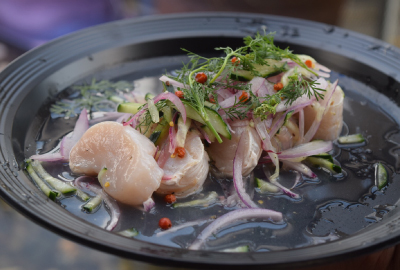
The lion’s claw or lion’s hand clam is a large species found in several South California lagoons and is highly valued for its texture and flavor. Its circular shell can measure up to 7.5 cm in diameter and is characterized by grooves that resemble a lion’s hand. Due to its delicious taste and freshness, the lion’s claw clam has become a delicacy in Baja California Sur and is widely used in the local cuisine.
One of the most popular ways to enjoy lion’s claw clams is in ceviche. Lion’s claw clam tripe ceviche is a typical dish that features this succulent ingredient as the main star. To prepare this dish, the clams are cleaned and sliced into thin strips, then marinated in a mixture of lime juice, onion, cilantro, and serrano chili pepper. The acidity of the lime juice helps to “cook” the raw clams while infusing them with flavor from the other ingredients. The result is a fresh, tangy, and slightly spicy dish that perfectly showcases the flavor and texture of the lion’s claw clam.
Grilled Chocolate Clams
The chocolate clam is a larger, less common mollusk found in the Pacific Ocean and Gulf of California. Its shell has a color similar to chocolate, which gives it its name. In Baja California Sur, the chocolate clam is grilled using the traditional tatemar technique, which means roasting on fire. This technique has been used since pre-Hispanic times and is still widely used in many states in Mexico.
To prepare grilled chocolate clams, they are grilled over an open fire until they are fully cooked, then served with lemon juice and hot sauce. The result is a rich and smoky flavor that is hard to resist. Grilled chocolate clams are a gastronomic symbol of the magical town of Loreto, located on the east coast of Baja California Sur. The town celebrates the Chocolata Clam Festival every June, where locals and tourists can savor this delicious dish.
Pickled Shrimp
Pickled shrimp is a long-lasting stew that is widely used when hunting and fishing are abundant. The technique of pickling meat and fish has been in use since the Romans in the third century AD, who were great promoters of their culture and taught us the method. Today, new technologies have contributed to the conservation of limited duration, vacuum packaging, as well as deep-freezing, but the old technique has not undergone any noteworthy change from the Roman legacy.
Shrimp Mixiotes
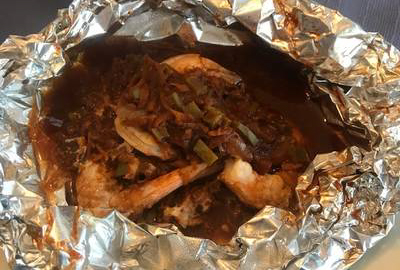
Mixiotes are a preparation of pre-Hispanic origin that is similar to tamales. The name comes from the Nahuatl metí “maguey” and xiotl “film or membrane of the stalk.” The use of the maguey cuticle and the steam cooking technique were well known by the Mayan, Aztec, and Otomi civilizations, among many others. Although the popularity of this dish lasted until the arrival and establishment of the first Spanish conquerors, it is considered that this food originated in those regions of Mexico where the maguey pulquero has been cultivated.
The dish consists of steaming a meat stew, especially lamb or lamb, and chili and herb sauce smelling like avocado leaves, bay leaves, thyme, epazote, marjoram, and oregano, wrapped in the maguey leaf. You can also find mixiotes stuffed with beef, pork, rabbit, chicken, fish, and shellfish, vegetables
Spicy Lobster from Baja California Sur
Subcalifornian spicy lobster is another dish that is typical of Baja California Sur. This crustacean is one of the main products of the state’s fishing industry and is used in various dishes in local restaurants. The most popular way to enjoy lobster in Baja California Sur is to have it cooked in butter and served with rice, beans, coleslaw, and sauces. However, there are many other ways to prepare this delicacy, including in tacos, soups, and salads. One of the best places to enjoy subcalifornian spicy lobster is on Paseo Álvaro Obregón, where you can taste some delicious lobster tacos while admiring the stunning view of the sea.
It is worth noting that the capture of subcalifornian lobster is done by hand using traps, which minimizes the impact on the environment and ensures that the lobster is of the highest quality. In the past, this dish was mainly served in expensive restaurants, but nowadays it is more common to find it in various places throughout the state, making it more accessible to locals and tourists alike.
Chiles Stuffed with Salmon in Nogada
This dish dates back to 1821, the year in which Agustín de Iturbide signed the Act of Independence of Mexico and the Treaties of Córdoba. Some say that it was the Augustinian mothers of the Convent of Santa Mónica in Puebla who created the dish that recalls the colors of the Trigarante Army flag. The dish consists of poblano peppers, roasted and peeled, then filled with a hash rich in ingredients and flavors based on pork, tomato, onion, garlic, seasonal fruits, walnuts, almonds, pine nuts, and various spices.
The sauce is made with fresh Castilla nuts, peeled perfectly and ground in the metate with fresh cheese, sugar, milk, and a bit of sherry. The dish is finished by frying the chiles, covering them with the sauce, and decorating them with red pomegranate seeds and parsley leaves, achieving the colors of the flag.
Typical Drinks of BAJA CALIFORNIA SUR
Coffee
When you think of Baja California Sur, coffee may not be the first thing that comes to mind. However, despite being a beach state, Baja California Sur experiences very cold periods, especially during the winter months. During these times, coffee becomes a popular beverage, both for warming up and keeping awake.
Although Baja California Sur is not a significant coffee producer, the state has a thriving coffee culture. You can find many cozy cafes that serve a range of coffee drinks, from classic espresso shots to trendy specialty drinks. Many of these cafes roast their beans in-house, ensuring the freshest and most flavorful coffee possible.
Damiana Liqueur
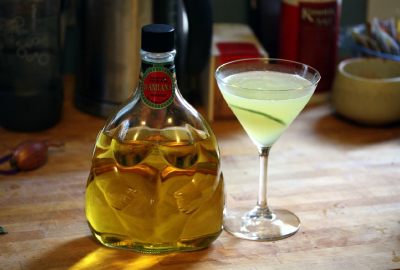
Damiana Liqueur is a liquor that has been produced in Baja California Sur for centuries. It has its roots in the pre-Hispanic era, when the indigenous Guaycurá ethnic group inhabited the peninsula. The Guaycurá used the damiana plant for medicinal purposes, as it was rich in nutrients, minerals, and healing properties.
Over time, the damiana plant began to be used for other purposes, including the creation of a delicious liqueur that is now one of the signature drinks of Baja California Sur. The liqueur is made by mixing damiana extracts with sugarcane spirits and has a sweet taste with herbal and refreshing notes. It is drunk on its own, with ice and in cocktails, and is the basis for making a cream that is famous as an excellent digestive.
The damiana plant grows wild in the arid areas of America, from California to Brazil, and has a pretty yellow flower. It contains abundant flavonoids and antioxidants, and antidepressant, relaxing and aphrodisiac properties are attributed to it. This delicious beverage is a must-try for anyone visiting Baja California Sur.
Cold Coconuts
Baja California Sur is surrounded by the Cortes Sea, the Gulf of California, and the Pacific Ocean, giving it the characteristics of an island. The region is home to more coconut palm trees than inhabitants, making it an ideal place to enjoy fresh coconuts.
The locals love to serve cold coconuts on the beach, providing a refreshing treat on a hot day. The water inside the coconut is full of electrolytes, making it an excellent hydration option. In addition, the coconut meat is rich in fiber, minerals, and vitamins, making it a healthy snack.
Drinking cold coconuts is an enjoyable experience that combines the taste of the tropical fruit with the relaxing atmosphere of the beach. It is also an excellent way to connect with the local culture and traditions of Baja California Sur.
Beer
Beer is undoubtedly one of the most popular drinks in Baja California Sur, and for a good reason. The state boasts over 80 craft beer factories that produce a wide variety of beers using high-quality raw materials, with barley being the most prominent. The unique flavor and aroma of Baja California Sur’s beer stem from the region’s water, which is rich in minerals and imparts distinctive characteristics to the beer.
In recent years, craft beer has become increasingly popular in Mexico, with more and more people opting for artisanal brews instead of mass-produced ones. You can find craft beer establishments all over Baja California Sur, each with its own unique atmosphere and offerings. From small breweries with a local vibe to trendy bars with a wide selection of beers, the state has it all.
Baja California Sur Wines
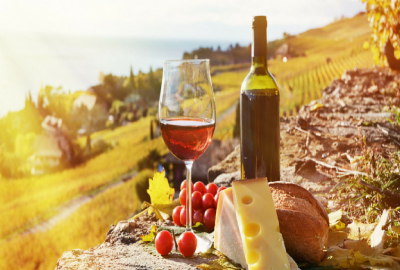
Baja California, especially the northern part, is famous for being one of the largest wine distributors in Mexico. However, the state of Baja California Sur is not far behind, as it is home to some of the finest vineyards in the country. Although wine is not native to this region, it has become one of the representative drinks of Baja California Sur. In fact, to date, 90% of the national wine is still produced in Baja California.
The harmony of flavors is what makes Baja California Sur wines stand out. The region offers a variety of wines, but some of the most popular ones among locals and tourists are Chennin Blanc and Cabernet Sauvignon. The largest quantity and variety of wines can be found in Ensenada, which is home to the main wine producer in all of Mexico. The Guadalupe Valley is the predominant area on the Baja California Wine Route, and it offers a range of wineries for visitors to explore. Apart from this, the Llano Colorado Valley and the Santo Tomás Valley also offer a variety of wines for visitors to enjoy.
If you are planning to visit Baja California Sur, a visit to the Valle de Guadalupe should be on your itinerary. This region is not only known for its wines but is also one of the most visited tourist destinations in the state. Visitors can take their time to savor the flavors of the wines, enjoy the picturesque view, and breathe in the fresh air. The best time to visit Valle de Guadalupe is during the Harvest Festival that takes place in August, where visitors can participate in wine tastings, grape stomping, and other exciting activities.
Fresh Waters
While wine may be the drink of choice for many, Baja California Sur also has a range of non-alcoholic drinks that are just as refreshing. In a region where the beach is the main attraction, nothing beats the classic fresh waters of different flavors. These drinks are a perfect way to cool off after a day spent soaking up the sun.
Fresh waters are made by blending fruits, seeds, and other ingredients with water and sugar. The result is a flavorful and refreshing drink that is perfect for the hot climate of Baja California Sur. Some of the popular flavors of fresh waters in the region include strawberry, orange, lemon, pineapple, and horchata.
Typical Sweets and Desserts of BAJA CALIFORNIA SUR
Chimangos
Chimangos are one of the most popular desserts in Baja California Sur. These sweet treats are made from wheat flour and piloncillo, which is a type of unrefined brown sugar that is commonly used in Mexican cooking. The recipe for chimangos has been passed down from generation to generation, and it is a cherished part of local culture.
To make chimangos, the dough is mixed with cinnamon and piloncillo, and then it is rolled out and cut into small pieces. The pieces are then fried until they are golden brown and crispy. Traditionally, chimangos are served with a cup of coffee or tea, but some people like to fill them with cheese and beans to give them a more savory flavor.
Chimangos have their origins in Spain, but they have been a beloved dessert in Baja California Sur for decades. They are a perfect example of the fusion of different cultures that has shaped the cuisine of the region. Whether you are enjoying them with a hot cup of coffee or alongside a plate of beans and cheese, chimangos are a sweet delight to savor.
Dulce de Zorrillo (Skunk Sweet)
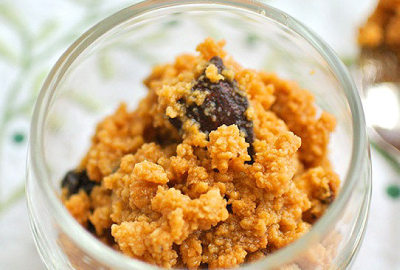
Dulce de Zorrillo, also known as Skunk Sweet, is a traditional sweet treat that is prepared on ranches in Baja California Sur. The name comes from the fermentation process that the milk goes through, which gives it a unique and distinctive flavor. In the past, it was made using cut milk so as not to waste it, but nowadays, it is more common to cut the milk yourself using lemon juice.
The recipe also calls for brown sugar, piloncillo, and cinnamon, which are added to the mixture along with the milk and lemon juice. The mixture is then cooked over low heat and stirred until it thickens and has produced lumps. Once it has thickened, it is allowed to cool before being served.
Baja California Sur Style Capirotada
Capirotada is a popular sweet in many parts of Mexico, and Baja California Sur has its own unique version of this dessert. The dish is made with bread that is toasted and then layered with nuts, peanuts, raisins, bananas, guava, and cheese. The whole thing is then sweetened with piloncillo, giving it a rich and complex flavor.
The bread used for capirotada can be any type, but it is usually made with bolillos, which are small rolls that are similar to baguettes. The bread is toasted until it is crispy and then cut into small pieces. The nuts, peanuts, and raisins are also toasted to bring out their natural flavors, and then they are layered with the bread.
The bananas and guava are added to the mix to give the dessert a fruity twist, and the cheese is crumbled on top to balance out the sweetness. Finally, the whole thing is drizzled with piloncillo syrup, which is made by boiling piloncillo with water until it forms a thick, caramel-like sauce.
Baja California Sur style capirotada is a delicious and nutty treat that is perfect for anyone with a sweet tooth. It is a great example of the way that local ingredients and flavors can be combined to create a dessert that is both traditional and innovative.
Dates
The desserts and sweets of Baja California Sur are made with a range of ingredients, including fruits, dairy products, and nuts. One of the most important fruits used in these desserts is the date, which is abundantly available in the region.
Dates are the fruit obtained from the Phoenix palm species, mainly the Phoenix dactylifera species. In Baja California Sur, this type of palm trees, popularly called date palms, abound. These fruits are rich in iron, potassium, calcium, and magnesium and are an important source of fiber. They also have a high calorie content, which makes them an excellent source of energy. Due to their sweet taste, they are also used to prepare a large number of prepared desserts and sweets.
Date bread
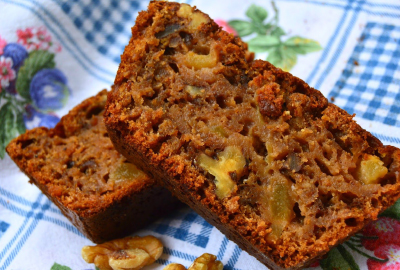
One of the most popular desserts made with dates is date bread. The date palm was brought to the New World by the Spanish and adapted very well to the Baja California peninsula, since it is a species of desert regions known in Asia as “desert bread”. The South Californian town of Mulegé is surrounded by date palms, and its bakers prepare an exquisite bread that has the intense and natural sweetness of the fruit with the pulp of the date, a food rich in carbohydrates and fiber to which toning properties are also attributed.
The date bread is made using the pulp of the fruit, which is mashed and mixed with flour, sugar, and other ingredients to form a dough. The dough is then baked in an oven until it is golden brown and has a fluffy texture. The result is a delicious bread that has a sweet and slightly tangy flavor, which makes it perfect for breakfast, snacks, or dessert.
In addition to date bread, there are many other desserts and sweets made with dates in Baja California Sur. One of them is the traditional date candy, which is made by mixing dates with sugar and cooking them until they form a thick, sticky mixture. This candy is often eaten as a snack or used as a topping for other desserts.
Another popular dessert made with dates is the date shake, which is a sweet, creamy drink made by blending dates with milk, ice cream, and other ingredients. This drink is refreshing and energizing and is often enjoyed during hot summer days.
Guayabate (Guava Sweet)
Another popular sweet treat in Baja California Sur is the Guava Sweet. This is a type of jam that is made from guava pulp and is usually served with cheese or dulce de leche. The texture of this sweet is thick and similar to jelly, and it has a very sweet taste that reminds us of quince jelly. It is commonly served on toasted bread and is a favorite among locals and visitors alike.
Pithaya (Dragon fruit)
One of the most popular fruits that are typical of this region is the pitahaya, or dragon fruit. This cactus grows in the arid regions of the peninsula, and it takes about 18 months to bear its fruit. The Pitahaya is an exotic fruit with an intense color of dark red, pink or yellow, with an interior that can be white or pink, depending on the variety of cactus from which it is collected. Its flavor is extremely sweet, making it perfect for desserts, flavored water, or ice cream.
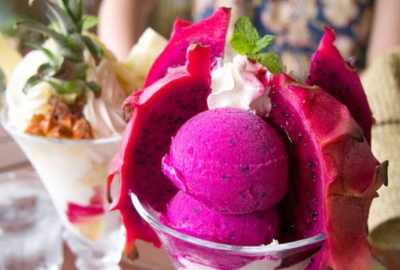
Pitahaya ice cream is a perfect treat for a hot afternoon in the city. This rich ice cream is made with the pitahaya, which is only found in the desert of the Yucatan peninsula. The fruit’s intense colors of yellow and red make it an exotic treat that is refreshing and delicious. There are different recipes for making pitahaya ice cream, including one with mezcal and lemon juice, another with orange juice, and the classic one with pitahaya only. All of them are equally refreshing, making them ideal for consumption during the summer.
Apart from ice cream, pitahaya is also used in other desserts, such as cakes, tarts, and fruit salads. The fruit’s sweet taste and beautiful color make it perfect for decorating desserts, and it also adds a unique flavor to any dish it is used in.
In Baja California Sur, pitahaya is also used to make flavored water, which is a refreshing drink that is perfect for hot summer days. To make pitahaya water, you need to blend the fruit with water and sugar, strain the mixture, and serve it chilled. The result is a sweet and refreshing drink that is perfect for quenching your thirst on a hot day.
Mango Jelly
Another beloved sweet treat of Baja California Sur is mango jelly, also known as mangate. Mangoes are a staple fruit in the region and are widely appreciated for their sweet and juicy flavor. To make mango jelly, all you need is water, sugar, and, of course, mangoes.
To prepare the jelly, the water and sugar are boiled together until they reach a thick consistency. The mangoes are then added to the mixture and boiled until they break down into a smooth and creamy texture. The resulting mixture is poured into a mold and left to cool and set, resulting in a delicious and refreshing dessert.
Mango jelly can be enjoyed on its own, or used as a topping for breads, cookies, and other baked goods. In addition to its delicious taste, mango jelly also has cultural significance in the region, as it is often served at traditional celebrations and festivals, such as the Mango Festival in the Magic Town of Todos Los Santos.
Biznaga Candy
One of the most iconic sweet treats of Baja California Sur is the biznaga candy. This unique candy is made from the biznaga cactus, a plant that is native to the region and is known for its distinctive shape and long, sharp thorns. To prepare the biznaga candy, the thorns and a thick layer of skin are removed from the cactus, and the remaining flesh is cut into small pieces.
Next, the biznaga pieces are immersed in a syrup made of sugar and water, which replaces the water content of the cactus with sugar. The biznaga pieces are left in the syrup for an extended period of time, usually up to 48 hours, until they become fully crystallized. Finally, the candy is dried to harden the surface layer, resulting in a solid and delicious treat.
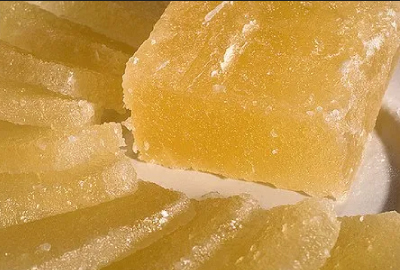
The process of making biznaga candy is time-consuming and requires a great deal of patience and skill, but the end result is well worth the effort. The candy is not only a delicious snack, but it also has cultural significance in the region, as it is often given as a gift or used in traditional celebrations and festivals.
Lemon Candy
The combination of sweet and sour is a classic flavor that appeals to many palates. In Baja California Sur, this flavor is embodied in the form of Lemon Candy, a traditional dessert that is easy to make and delicious to eat. Lemon Candy is a recipe that has been passed down through generations and can be found in local markets and homes alike.
To make Lemon Candy, you will need either green or brown lemons. The brown lemons are the ones that have reached their maturation stage, but both varieties are acceptable for this recipe. The preparation process for Lemon Candy is somewhat tedious, as the lemons have to be boiled multiple times. However, the end result is worth the effort.
To start making Lemon Candy, you need to boil the lemons in water until they are soft. Then, you cut the lemons in half and remove the pulp and seeds. The lemon peels are boiled again in water until they become tender. Afterward, the lemon peels are cut into thin strips and boiled in sugar syrup until they become translucent. Finally, the lemon strips are coated in sugar and left to dry. The result is a sweet and tangy candy that melts in your mouth.
One of the unique aspects of Lemon Candy is that it can be customized with different fillings and coatings. Some popular fillings include coconut, nuts, and condensed milk. Additionally, the candy can be coated in chocolate or chili powder for added flavor. Lemon Candy is a versatile dessert that can be enjoyed on its own or as a complement to other dishes.
Panocha de Gajo (Sweet Cane)
Panocha de Gajo is a traditional sweet treat that is made with sugar cane juice and orange peel. This delicacy is made in San José de Comondú, where the locals have perfected the recipe over the years. To make Panocha de Gajo, the sugar cane is squeezed, and the juice is extracted. The juice is then boiled in a large saucepan over a wood fire for several hours.
During the cooking process, foam is generated, which is removed with a strainer. Once the mixture has thickened, orange peels are added, and the mixture is cooked until it reaches a more consistent texture. The mixture is then poured onto a wooden board, forming a large cube, from which small squares are split depending on the desired size.
Sweet Bean Empanadas
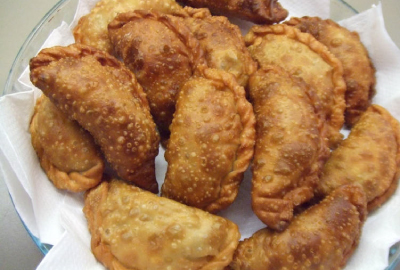
When it comes to Mexican desserts, empanadas are not typically associated with sweetness. However, in Baja California Sur, there is a traditional dessert called Sweet Bean Empanadas that combines the savory texture of beans with the sweetness of cinnamon and sugar. Sweet Bean Empanadas are a popular snack or breakfast food that can be enjoyed throughout the year.
To make Sweet Bean Empanadas, you will need to cook beans until they reach a pasty consistency. You can use canned beans or cook your own from scratch. The beans are then fried in oil with cinnamon, cloves, and piloncillo or brown sugar. The result is a sweet and creamy filling that is perfect for empanadas.
To make the empanada dough, you will need warm water, wheat flour, butter, and salt. The dough is rolled out and cut into circles, then filled with the sweet bean mixture. The edges of the empanadas are crimped to seal the filling inside, and the empanadas are fried until golden brown. Sweet Bean Empanadas can be served hot or cold, and are often accompanied by ates (a type of fruit paste) and stuffed or crystallized dates.
Chopito
Chopito is a type of ranch cheese that is very popular in Baja California Sur. The word chopito is used to refer to ranch cheese, regardless of its animal origin, texture, and flavor. In Los Cabos, cow cheeses are more common, while in La Paz, chiva cheese abounds. The options will also depend on what time of year you visit the state, as the cheese will vary depending on the season. During the winter season, leftover cheese is used to make creamy and small chopitos made with fat milk. In other seasons, you will get square cheese chopitos. Chopito is often served with other Baja California Sur or national desserts, such as lemon candy or sweet bean empanadas. The contrast of the acid with the sweet is something key that you must experience to understand the local cuisine.
More Tourist Attractions in BAJA CALIFORNIA SUR
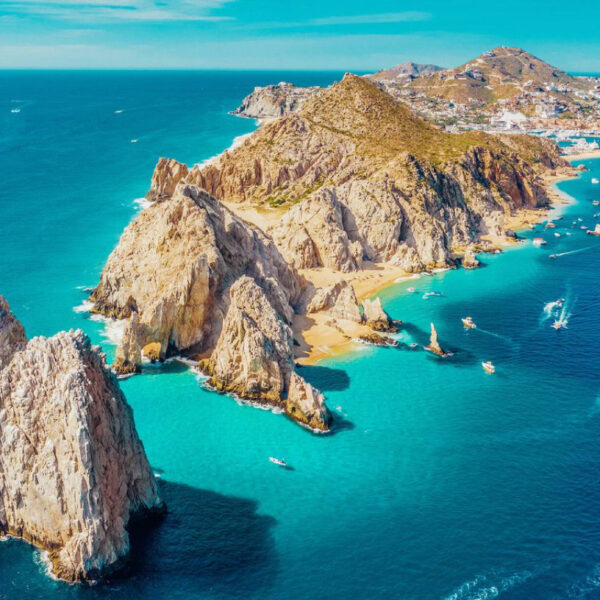
Los Cabos
Los Cabos, located at the southern tip of the Baja California peninsula, is a captivating tourist destination that promises a unique blend of natural beauty, tranquil provincial life, exciting adventure opportunities, and lively entertainment options. With two main cities, San José del Cabo and Cabo San Lucas, connected by the Los Cabos Tourist Corridor, Los Cabos offers a wide range of attractions and activities that cater to the interests and budgets of both Mexican and international tourists.… Read More
Guided Tours in BAJA CALIFORNIA SUR
Flights & Hotels in BAJA CALIFORNIA SUR
More Tourist Attractions in MEXICO

Gastronomy
The Gastronomy of Mexico has a great diversity of typical dishes, which is why it was recognized by UNESCO as Intangible Heritage of Humanity. The basic and representative ingredients of Mexican dishes are: corn, coriander, chili, beans, piloncillo, nopal and tomato. Mexican cuisine is also characterized by its sauces, which serve as an accompaniment to traditional dishes, prepared based on spices.… Read More

Traditions in Mexico
It is practically impossible to make a meticulous, and above all, accurate selection of the places to visit in Mexico. Each place that our country houses is unique and beautiful in its own way. Mexico, with its nearly 2 million km², has a large number of scenarios to offer, as well as endless activities to do. Do not lose your way and enter the places to visit in Mexico. In Mexico, apart from the beaches and its famous archaeological sites, there are many other really interesting sites and activities that you should know. In the surroundings of the main cities you will find places full of culture and tradition, where you can spend relaxing, interesting and fun vacations. On your trip through Mexico you cannot stop obtaining souvenirs, the crafts that are made here are of the highest quality and recognized worldwide. A shopping tour cannot be missed.… Read More

Beaches
On the Beaches of Mexico you can immerse yourself in the intense blue ocean of the Pacific bays, sunbathe on the shore of the warm and transparent waves of the Caribbean Sea in Quintana Roo or even rest on the beautiful coasts of the Gulf of Mexico. Mexican beaches hide wonderful secrets for the traveler. By visiting them, in addition to enjoying the excellent climate and water activities, you can discover splendid archaeological sites and interesting colonial cities without traveling long distances.… Read More

Archaeological Sites
The Archaeological Zones are the cultural past of every Mexican. You will be amazed at the ambient, nature and the environment that surrounds them. Climbing to the top or being around it will take us back in time to admire every detail. México is a country of culture and traditions, many of which we have inherited from the pre-Hispanic inhabitants of this vast territory, although it is true that there were more settlements in the central and southern part of the country, it is also possible to find some archaeological remains in the north.
… Read More

Capital Cities
Folklore, gastronomy, literary culture, art and exhibitions, is what you will find in the capitals of the states of Mexico. To the north, colonial Mexico, Puebla, Guadalajara, Guanajuato, the Sonoran desert and the California peninsula. To the east Veracruz and the gulf. To the west Acapulco, Oaxaca and Tuxtla Gutiérrez. And to the south the Riviera Maya and the pyramids of Chichén-Itzá, Tulúm and Cobá in Yucatán, Palenque in Chiapas, the cenotes, and the Central American jungles.… Read More

Magical Towns
A Magical Town is a place with symbols and legends, towns with history that in many cases have been the scene of transcendent events for our country, they are places that show the national identity in each of its corners, with a magic that emanates from its attractions ; visiting them is an opportunity to discover the charm of Mexico. The Magical Towns Program contributes to revalue a set of populations in the country that have always been in the collective imagination of the nation and that represent fresh and varied alternatives for national and foreign visitors. A town that through time and in the face of modernity, has conserved, valued and defended its historical, cultural and natural heritage; and manifests it in various expressions through its tangible and intangible heritage. A Magical Town is a town that has unique, symbolic attributes, authentic stories, transcendent events, everyday life, which means a great opportunity for tourist use, taking into account the motivations and needs of travelers.… Read More

States Of Mexico
Mexico has an incredible diversity of landscapes, where the beauty of its beaches, internationally recognized, stands out. In its vast territory of coasts, there are beaches of unparalleled beauty, and colorful landscapes. A large network of first-class hotels and tourist services is available to visitors to these beaches. Mexico is also mystical places, dotted with archaeological testimonies inherited from its original inhabitants. Monuments made by the Mayas, Aztecs and Toltecs are located in magical landscapes, like lighthouses in an ocean of natural beauty. They offer visitors buildings that tell their history, and museums that collect their cultural heritage. And that keep alive ancestral traditions, in ceremonies and festivals, where you can enjoy cultural activities and entertainment.… Read More

Ecotourism and Adventure
Mexico is one of the best countries for Ecotourism as it has a great variety of flora and fauna, as well as a large number of refuges for extraordinary species. You can enjoy recreational activities of appreciation and knowledge of nature through contact with it, such as: stargazing, observation of natural attractions, wildlife and bird watching. Throughout México there are more than 176 protected natural areas, 5 of them considered by UNESCO as Natural Heritage of Humanity. Just for this and much more, we believe that Mexico is a Paradise for Ecotourism.… Read More

